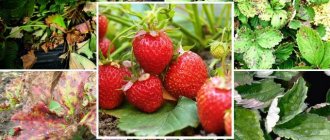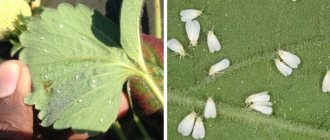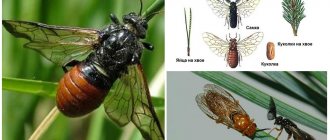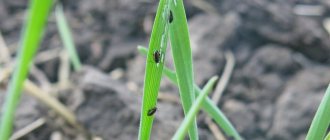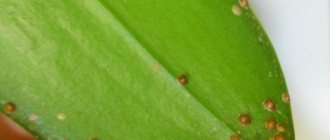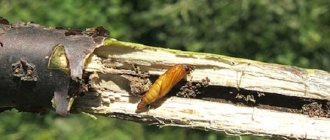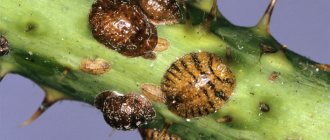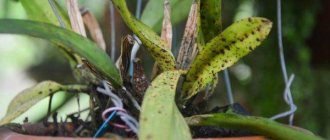Nematodes are small worms that are dangerous enemies of garden and vegetable crops. The worm belongs to the phylum protostomes. Of these, there are more than 24 thousand species that infect people, animals and plants. They live in fresh and salt water, in the ground.
The strawberry nematode has a mouth similar to tweezers or forceps, with which the parasite clings to the foliage and fruits of the plant, destroying them. The peculiarity of these worms is that they are resistant to some new generation pesticides and cannot be overcome with all means.
Before fighting nematodes on strawberries and wild strawberries, it is necessary to determine the type of parasite, there are several of them:
- stem worms often grow on twig plants and infect the stem;
- leaf worms (including strawberry worms) destroy leaves and fruits;
- root worms that attack the root system of plants.
What does a nematode look like on strawberries: description with photo
The presence of parasites at different stages of strawberry development is determined by the following symptoms:
- Strawberries begin to grow around spring. In some regions with warm climates in late January - early February. If worms appear in the garden bed, they infect the stems and leaves, which then turn yellow and curl. If you look closely, the naked eye can see a nematode or eggs on the back of the foliage.
- The next stage is the peduncle , after which the bushes begin to bloom. When exposed to parasites, the color of the plant changes. The leaves turn from green to brown or yellow, the flowers fade, and the ovary does not form.
- After flowering, the phase of growth and fruit ripening . If parasites appear during this period, the fruits do not grow or turn red, but die green. Fruits may form slowly and incorrectly - crooked, shapeless.
Nematodes are difficult to detect due to their tiny size. To make sure there are parasites on strawberries, you need to pull out the bush and carefully examine its root system. If a nematode is present, white or yellow cysts the size of a poppy seed can be seen on the strawberry roots (pictured):
What is a nematode
The nematode is an extremely tenacious and voracious parasite . Its eggs can remain in the ground for about 10 years, waiting for conditions acceptable for development. Due to their small size - the length of an adult varies from 1 to 20 mm depending on the variety - they are quite difficult to detect. Nematodes is a roundworm, a genus of protostomes. It has a white, sometimes slightly yellowish color.
Various individuals parasitize on nightshade, vegetable crops, garden flowers, and strawberries. For the latter, leaf and stem nematodes are dangerous. These are small worms whose length ranges from 0.5–1 mm. Found on tomatoes, strawberries, and chrysanthemums.
| Temperature favorable for reproduction | +18°С |
| Generation | 20 per year |
| Female | 0.525–0.685 mm |
| Male | 0.435–0.562 mm |
Important! Adult worms and eggs laid by the female are in an earthen coma, which prevents the timely identification and destruction of the pest.
The worm has a special structure of the oral cavity. Sharp forceps that bite through the surface tissue of plants are designed to inject a special secretion. It, reacting with the sap of the plant, is converted into a nutrient that is absorbed by the nematode in full. An additional difficulty is the contamination of strawberries with concomitant diseases, most often of fungal etymology.
There are male and female individuals - there are differences in color, shape, size : females are yellowish in color and more rounded, which is explained by bearing offspring. Eggs are not laid, and when unfavorable conditions arise for further growth, the female becomes a cyst.
Did you know? The parasite is present in almost every area, but it can cause significant harm only in the case of a large concentration.
Thus, a colony of 1000 individuals per 1 m² of land is considered dangerous. The capsule can contain about 1000 eggs, protected by a durable shell. The protection is so strong that it is not affected by weather conditions or chemical treatment.
Causes
The nematode starts under certain conditions, which are the reasons:
- 5.5–5.8 pH is the permissible acidity of the soil in which the worm starts; under other conditions there will be no infection;
- air temperature +25...+30 C , if it is colder or warmer, the larvae do not survive;
- decreased plant immunity due to lack of nutrition, drought or, conversely, excessive moisture.
The main reason for the appearance of parasites is the use of infected seedlings.
Factors contributing to infection
To infect a strawberry bush with roundworms, a combination of several risk factors is necessary:
- Excessive watering and poor drainage system.
- High air temperature.
- Excessive layer of sand in the soil. It is sand that can become a source of infection, because the nematode is characterized by complex circulation in nature.
- Nearby strawberry bushes can contribute to the rapid spread of the parasite in the crop.
Any decrease in the plant’s immunity can lead to infection and the rapid appearance of symptoms of the disease. The cause of a weakened immune status can be a pathogenic fungus, pathogenic bacteria, or hypothermia of the leaves (for example, during spring frosts).
Pest danger
When the strawberry nematode begins to infect the beds, the plants wither and wither. If measures are not taken in a timely manner, the harvest may be lost. Parasites carry many phytopathogenic microorganisms, which easily penetrate plant tissue through affected areas, which are eaten away by nematodes. This is fraught with infectious contamination, disease or loss of harvest.
Nematodes, when they land on strawberries, feed on them, grow stronger and begin to multiply intensively. Colonies are not easy to defeat, so it is important to notice the appearance of worms at the initial stage, before they create entire colonies under each leaf.
Signs of strawberry damage
The nematode is not easy to detect due to its small size and transparent body. You can assume that these pests have spread throughout the garden bed based on the appearance of the bushes.
How to identify a nematode
Strawberry plantings should be periodically inspected so as not to miss the onset of the disease. Bushes infected with nematodes are very different from healthy ones. They hardly grow, the petioles become bent, the leaves become covered with brown spots and gradually wither. Galls appear on the roots and above-ground parts - thickenings caused by pest bites.
In diseased bushes:
- the leaf plate is compressed into an accordion;
- antennae and petioles are swollen;
- sockets are deformed;
- flowering is scanty;
- the berries are small and ugly;
- the core of the bush dies.
The aerial part of a diseased strawberry may look different depending on the action of the bacteria introduced to the strawberry by the nematode.
Forms of changes:
- “Cauliflower” - thickened and shortened aerial parts, small modified flowers, dark green curled leaves.
- “Redness” - thinned petioles, red-violet leathery leaves, lack of pubescence on the petioles.
- “Awls” are small leaves on which part of the leaf plate between the veins is missing.
On the roots of strawberries you can see small white balls reminiscent of semolina. These are cysts filled with eggs.
Brought into the area with infected seedlings, the nematode begins to spread to neighboring strawberry bushes. In the middle of healthy bushes, groups of sick or dead plants - “bald spots” - form. This is also a sign of a pest.
Appearance of the pest
Strawberry nematode is a leaf variety. It is a round filamentous worm whose body length ranges from 0.5 to 0.9 mm. Males are light, thin, and smaller in size. Females are round, yellowish, they carry eggs, and each cyst can contain up to 1000 eggs. One generation develops in about 10 days; about 20 generations appear per season.
The nematode lives in the soil, where it overwinters in any form: eggs, larvae, adult. In the spring it moves to young shoots and attaches to parts of the plant.
The best conditions for the existence of the parasite are air temperature +25–30°C and slightly acidic soil (pH from 5.5 to 5.8 units). But in the cyst stage, the pests are not afraid of either chemicals or frost. They can wait more than 10 years for favorable conditions to hatch and settle in new plantings.
Prevention of occurrence
It is easier to prevent the disease than to later fight the nematode on strawberries. Gardeners recommend the following methods of prevention:
- purchase seedlings only from trusted suppliers to avoid contaminated planting material;
- before purchasing/planting, you need to carefully examine the root system and not the subject of cysts;
- before planting, it is recommended to treat the plants with warm water (not boiling water), at temperatures above +30C the nematodes die;
- several times a season you need to compost the soil and feed the bushes to increase the protective functions of strawberries;
- In spring and autumn, be sure to remove all weeds from the garden bed and burn them to destroy possible parasites.
Strawberry seedlings
Pest Control Methods
If a pest has settled in your area, the question arises of how to get rid of the parasite. This is not easy to do - the process can last from 3 months or longer. In this case, an integrated approach should be used using the methods listed in the table:
Affected plants - regardless of season
The methods are selected comprehensively, depending on the condition of the strawberries on the site.
Chemicals
Treatment with chemicals is a last resort when other methods have proven their impotence. With the right approach and following all the rules, the negative consequences of such exposure can be minimized.
The most effective drugs:
"Heterophos" is a highly toxic pesticide
When working with it, it is important to follow safety rules, use respirators and gloves. No excavation work can be carried out for 45 days after treatment
To prepare the working fluid, you need to dissolve 15 g of the drug in 10 liters of water. The product is suitable for treating growing bushes and soaking seedlings.
“Lindane”, “Ruskamin” - the chemical shows its effectiveness in the fight against adult individuals, but is not capable of destroying the chitinous cover of the cyst.
“Phosfamide” - used as a 0.02% solution, which needs to be sprayed every 3-5 days.
"Mercaptophos" is a drug whose effect is similar to "Phosfamide".
To carry out chemical treatment, it is necessary to dilute the selected preparations in accordance with the instructions, then water or spray
Remember - the parasite lives on the plant and in the earthen coma, so special attention should be paid to soil cultivation
Folk remedies
If you do not want to treat strawberries infected with a nematode with chemicals, you can use folk remedies. The preparation of tincture recipes is based on the beneficial properties of plants and products. This approach to preventing and getting rid of parasites will significantly reduce their population while preserving the harvest.
Nasturtium, nettle, marigold, hogweed, calendula, etc. can be used as helper plants. Below we present several recipes to help gardeners.
Hot water treatment
Hot water treatment is performed:
- before planting newly acquired seedlings;
- when changing the place where strawberries are planted;
- when an area is infested with nematodes.
To do this you need:
- wash the root system of the plant, removing the entire earthen lump;
- pour hot water into a deep container - +45...+55°C;
- place strawberry seedlings there for 15–20 minutes.
To prevent the plants from boiling, it is prohibited to use hotter liquid.
Marigold tincture
Marigolds are a fragrant flower crop. As a preventive measure, it is used for planting around the perimeter of garden beds with wild strawberries. The sap of the flower is poisonous to parasitic worms. In case of nematode infection, the bushes are watered with the prepared infusion.
To do this you need:
- take 1 kg of crushed flowers;
- fill them with 1 liter of water;
- let it brew in a dark, cool place for 48 hours.
Afterwards the product is filtered and can be used for watering.
Onion infusion
To make onion infusion, you need to chop 200 g of onion and add 5 liters of clean water. After 24 hours of infusion, the strawberries are watered. For the purpose of prevention, the procedure should be repeated every 14 days, to get rid of nematodes - every 7 days.
Calendula infusion
Infusion of calendula, or marigold, is another equally effective remedy. To obtain it, you need to pour 200 g of dried inflorescences into 5 liters of water. Leave the closed container with the product in a warm room for 24 hours.
Control measures
The fight against nematodes on strawberries can be carried out in several ways. Chemical is the most effective, but can sometimes cause harm. Traditional methods are harmless, but over the years of practice they have also proven their effectiveness in the fight against parasites of various types.
Chemistry
Chemicals to combat parasites are available in the form of concentrated powders and ampoules, which are used for watering and irrigating crops.
The main effective drugs for nematodes on strawberries:
- Phosphamtide is an insecticide of contact and systemic action. Used to disinfect plants and animals.
- Heterophos is a new generation soil insecticide that is used to combat root parasites.
- Mercaptophos is an aqueous emulsion for spraying crops. Effective within a few hours after use.
- Chloropicrin is a broad-spectrum agent that has fungicidal, herbicidal and insecticidal properties.
Popular measures
Traditional methods are very popular among many gardeners due to their ease of use, cheapness and harmlessness. Chemicals are toxic and have side effects, and folk remedies are based exclusively on natural ingredients of plant or animal origin.
Methods for controlling nematodes on strawberries:
- Onion infusion . Fruits or onion peels are used, which intensively fight not only nematodes and helminths, but also other parasites in the garden - aphids, butterflies, caterpillars, bedbugs. Chop 400 g of onion and add a bucket of water. leave for several hours and water the strawberries with this product once a week. Substances contained in onions have a disinfecting and antiseptic effect, destroying pathogenic microflora.
- An infusion of marigolds is a real poison for many pests in the garden. To prepare the product, pour 5 kg of tops with 5 liters of water and leave in a dark, cool place for 2 days. After this, you need to strain and water the strawberries.
- Marigolds or calendula will help eliminate parasites at the initial stage. For 1 liter of water you need 10 tbsp. l. dried plant. Leave for a day and water once a week. Calendula has antiseptic properties and destroys almost all fungal and bacterial microorganisms.
Agronomic
In addition to irrigating and watering strawberries, you need to adhere to agrotechnical rules for caring for crops in order to avoid nematosis and other diseases that occur when exposed to parasites:
- It is important to observe crop rotation . These are schemes for rotating crops in the garden with the aim of eliminating parasites, improving the soil and increasing yield. If you grow the same crop in one place for many years, the soil is depleted and the yield decreases.
- To reduce the risk of infection with nematosis, experts recommend choosing varieties that are resistant to the effects of worms . For example, Festival, Zhemchuzhnitsa, Dessert.
- Before planting or replanting, you need to treat the soil, disinfect it and fertilize it . This will significantly increase the plant’s immunity and its protective functions.
If, during the process of growth and development, infected bushes appear in the garden bed, they must be uprooted immediately and preventive measures must be taken to prevent the others from becoming infected.
A set of measures according to the calendar
Therapeutic and preventive treatment against nematodes is carried out throughout the season. The main thing is to use the method that best suits the phase of vegetative development of the plant:
- In the spring, the beds are fertilized with nitrogen and potassium. You can use wood ash or banana fertilizer, which is also rich in potassium.
- After harvesting, the bushes must be treated with chemicals to destroy pathogenic microflora.
- In the fall, you need to carry out an audit, that is, an inspection of all the bushes. Infected and damaged ones need to be replaced.
- If necessary, throughout the growing season you can treat with poisons from pests, folk remedies or hot water.
Every few years the crops need to be swapped in the beds.
Questions and answers
“Epin – extra” is a unique growth stimulator that not only activates the development of the plant, but also increases immunity, which allows the plant to independently protect itself from diseases and pests, including nematodes.
Question No. 1. How long does it take to get rid of nematodes on strawberries?
Unfortunately, it is impossible to completely eliminate the nematode, but it is possible to reduce the number to a safe amount. Why does prevention and pest control need to be carried out constantly?
Question number 2 . Are nematodes dangerous for humans and pets?
No. The structure of the worms and nutritional needs are designed exclusively for plant juices.
Question number 3 . If strawberries are planted under agrofibre, will it protect against nematodes?
It will not be possible to completely get rid of the worm, but it will be possible to reduce the number and protect the strawberries. Spunbond creates conditions of high humidity that are uncomfortable for worms, which does not contribute to their spread.
Question number 4 . What drug is guaranteed to kill nematodes?
Unfortunately, such a tool has not yet been created. Substances that destroy worms belong to the group of nematicides. The difficulty is that most of them act on adults and damage the eggs. Those, in turn, can wait for favorable conditions for years. That is why it is necessary to carry out preventive measures and ensure that the number of pests does not increase.
Question number 5 . How to determine when purchasing whether there are nematodes on strawberries?
When purchasing seedlings, you need to carefully examine the roots and stems, especially those sold in pots with a lump. There should be no small whitish grains, similar to semolina, this is what females look like, filled with numerous eggs.
Symptoms of damage and reasons for the appearance of nematodes on strawberries
The difficulty of diagnosis lies in the fact that it is impossible to detect a microscopic worm at an early stage. Often external signs of damage resemble a lack of nutrients:
- Bush growth slows down;
- The ovary and fruits are deformed;
- The leaves noticeably become smaller and curl up, and swellings—galls—appear on the upper surface;
- The petioles thicken and shorten.
External signs of the disease appear during flowering and fruiting. In this case, the pest cannot be detected.
You can see the nematode under a microscope; the worm is transparent. Detecting a nematode is very difficult. It not only sticks to the plant, but damages the tissue and causes infection. Most often these are pathogens of fungal diseases. This way the pest infects the strawberries.
Nematodes are present in any soil, but they are dangerous when they are concentrated in one place. This is precisely what can explain the defeat of just a few strawberry bushes, which creates bald spots in the plantings. Complete drying out is rare when the number of nematodes exceeds 1 thousand pieces per 1 square meter. cm.
Worm eggs can remain viable for many years, and under favorable conditions become more active. Particularly intensive growth is observed on moderately moist, acidic soils pH – 5.5 – 5.8, at temperatures + 24 – + 30. Most often, nematodes appear together with infected seedlings.
When purchasing strawberry seedlings, it is important not only to evaluate the appearance of the bush, but also to carefully examine the roots.
Even if no external signs of damage are found, before planting you need to take measures against the spread of the pest. Carefully inspect the roots. There should be no suspicious spots or inclusions on them. For prevention, pour hot water over the roots.
What are the signs to identify a nematode?
The main signs of the nematode are depressed, squat plants and stunted growth. Leaves, peduncles, petioles, deformed mustaches,
- The leaves wrinkle, curl, may become smaller, become leathery (rough and similar to corrugated paper), and look as if they are pulled towards the central vein. The central vein of the leaf has swelling, it seems that the leaf is broken in several places.
- The petioles are shortened, thick, twisted, acquire an atypical reddish color, and the pubescence disappears.
- Stems thicken and branch heavily
- The buds, flowers and ovaries take on an ugly shape, sometimes forming like a miniature green head of cauliflower.
- Pale green growths form on the mustache, the mustache is thickened and shortened.
- Berries become small and ugly
- The tissues of leaves, petioles, peduncles and tendrils become loose.
The signs of mite and nematode infestation are very similar. The main difference: with a nematode, dark green leathery spots appear on the leaf, and with a mite, the leaf becomes lighter.
This is useful
It is important to remember that all products that are intended to destroy helminths and nematode worms act on all parasites (aphids, bedbugs, beetles). But not all parasite killers kill worms. It is not easy to remove the nematode, so it is better to carry out all kinds of preventive measures.
If worms settle on one bush, they will not completely destroy it until they move to another, so you need to immediately uproot damaged plants to avoid mass infection with nematosis.
And lastly, you should not throw up torn nematous bushes into a compost pit, because worms can live for a long time and still contaminate fertilizers. The most effective way is to burn away from the beds.
How to prevent nematode reproduction?
In order to prevent the nematode from multiplying in the strawberry bed, preventive measures must be observed when planting and growing this berry crop.
You can bring the pest to your site with the soil and on the roots of planting material. Therefore, when purchasing seedlings, you must carefully examine the root system. The roots must be clean and strong, without particles of unknown origin. And even a completely healthy plant should be kept in hot water before planting. The fact is that nematodes cannot withstand temperatures above +40°C, and such heat treatment will not harm the plant.
When purchasing strawberry seedlings, you should give preference to varieties that are resistant to diseases and pests, for example “Gnuchka”, “Raketa”, “Desertnaya” and others. Before planting, young strawberry bushes should be disinfected with an aqueous solution of Parathion, and new leaves should be sprayed with 1% Bordeaux mixture.
Before planting strawberries, add fresh compost to the soil. It contains a fungus that is destructive to the nematode.
Next to the strawberry bed you can plant marigolds, calendula or nasturtium. These flower crops release substances into the soil through their roots that have a detrimental effect on parasites. In addition, you can dig a shallow ditch around the bed and fill it with lime, which will repel pests.
You should not arrange beds with strawberries in places where tomatoes, potatoes, cabbage, carrots, and beans previously grew. These crops are most favorable for the reproduction of parasites.
During the growing season, it is necessary to weed the plantings, removing the weed from the area and burning it. This will help significantly reduce the nematode population.
How to process correctly, step-by-step instructions
For treatment to be effective and give results, it should be performed according to a certain scheme:
- In spring, a thorough inspection of the entire strawberry plot is important. It is necessary to inspect the bushes weekly. At this time, organic fertilizer with potassium is introduced. It is good to use wood ash.
- During the growing season, treatment with growth stimulants is necessary. The drug "Epin" has proven itself to be excellent. Its additional effect is to strengthen the immunity of strawberries.
- If infected bushes are found, they should be immediately dug up and the rhizomes thoroughly washed with hot water.
- After fruiting ends, treatment with chemicals is necessary.
- In autumn, the season ends with the application of phosphate-potassium fertilizers.
Also, the most common mistake gardeners make is using insecticides to kill nematodes. However, drugs in this group act exclusively on insects and have no effect on worms at all.
